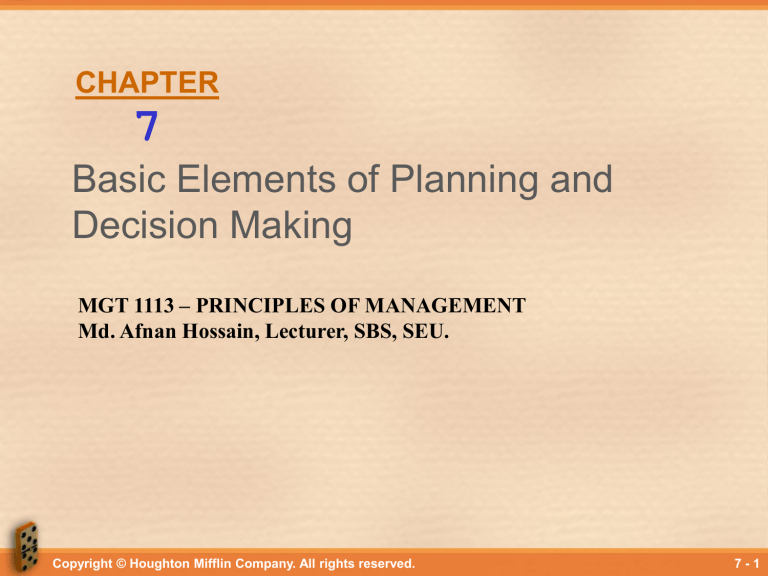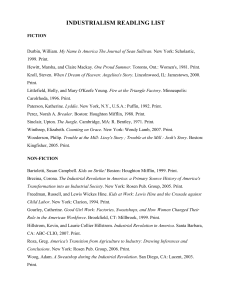Basic Elements of Planning and Decision Making

CHAPTER
7
Basic Elements of Planning and
Decision Making
MGT 1113 – PRINCIPLES OF MANAGEMENT
Md. Afnan Hossain, Lecturer, SBS, SEU.
Copyright © Houghton Mifflin Company. All rights reserved. 7 - 1
Organizational Goals
• Goals are critical to organizational effectiveness and serve a number of purposes.
• Purposes of goals:
– Provide guidance.
– Promote good planning.
– Serve as sources of motivation.
– Mechanism for evaluation and control.
Copyright © Houghton Mifflin Company. All rights reserved. 7 - 2
Kinds of Goals
• Goals vary by level, area, and time frame.
• Mission: a statement of an organization’s fundamental purpose.
• Strategic goal: a goal set by and for top management of the organization.
• Tactical goal: set by and for middle managers of the organization.
• Operational goal: set by and for lower managers of the organization.
Copyright © Houghton Mifflin Company. All rights reserved. 7 - 3
Other Goals
• Area: organizations also set goals for different areas.
• Time frame: organizations also set goals across different time frames.
Copyright © Houghton Mifflin Company. All rights reserved. 7 - 4
Responsibilities for Setting Goals
Who sets goals?
– All managers should be involved in the goal setting process.
– Each manager has responsibilities for setting goals that correspond to their level.
Copyright © Houghton Mifflin Company. All rights reserved. 7 - 5
Managing Multiple Goals
• When setting goals organizations sometimes experience conflicts or contradictions among goals.
• Conflicts are addressed through the use of the
Optimizing concept:
– Optimizing: balancing and reconciling possible conflicts among goals.
Copyright © Houghton Mifflin Company. All rights reserved. 7 - 6
What is to be accomplished?
The planning function consists of:
Copyright © Houghton Mifflin Company. All rights reserved.
How is it to be accomplished?
7 - 7
Objectives
Actions
Planning has 4 elements:
Resources
Copyright © Houghton Mifflin Company. All rights reserved.
Implementation
7 - 8
Why Is Planning Important?
What has to be done
A task can not be accomplished if the manager is not aware of:
How is it to be done
When is it to be done
Copyright © Houghton Mifflin Company. All rights reserved. 7 - 9
Organizational Planning
Kinds of organizational plans:
• Strategic plan: a general plan outlining decisions of allocation, priorities, and action steps necessary to reach strategic goals.
Copyright © Houghton Mifflin Company. All rights reserved. 7 - 10
• Tactical Plan: A plan aimed at achieving tactical and developed to implement specific parts of a strategic plan.
• Operational plan: a plan that focuses on carrying out tactical plans to achieve operational goals.
Copyright © Houghton Mifflin Company. All rights reserved. 7 - 11
Time Frames for Plans
• Long-range plan: covers many years, perhaps even decades; common longrange plans are for five years or more.
• Intermediate plan: usually covers periods from one to five years.
• Short-range plan: generally covers a span of one year or less.
Copyright © Houghton Mifflin Company. All rights reserved. 7 - 12
More Types of Plans
• Action plan: used to put into operation any other kind of plan.
• Reaction plan: designed to allow the company to react to an unforeseen circumstance.
Copyright © Houghton Mifflin Company. All rights reserved. 7 - 13
Responsibilities for Planning
• Planning staff: some large organizations develop a professional planning staff.
• Planning task force: often comprised of line managers with special interest in the relevant area of planning.
• Board of directors: establish the corporate mission and strategy, and in some companies take part in the planning process.
Copyright © Houghton Mifflin Company. All rights reserved. 7 - 14
Contingency Planning
• The determination of alternative courses of action to be taken if an intended plan of action is unexpectedly disrupted or rendered inappropriate.
Copyright © Houghton Mifflin Company. All rights reserved. 7 - 15
Crisis Management
• The set of procedures the organization uses in the event of a disaster or other unexpected calamity.
• A related concept is the set of procedures the organization uses in the event of a disaster or other unexpected calamity.
Copyright © Houghton Mifflin Company. All rights reserved. 7 - 16
Barriers to
Goal Setting and Planning
Major Barriers
– Inappropriate goals.
– Improper reward system.
– Dynamic and complex environment.
– Reluctance to establish goals.
– Resistance to change.
– Constraints.
Overcoming Barriers
– Understanding the purposes of goals and planning.
– Communication and participation.
– Consistency, revision, and updating.
– Effective reward system.
Copyright © Houghton Mifflin Company. All rights reserved. 7 - 17




